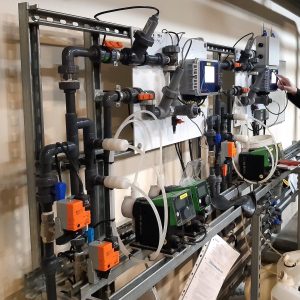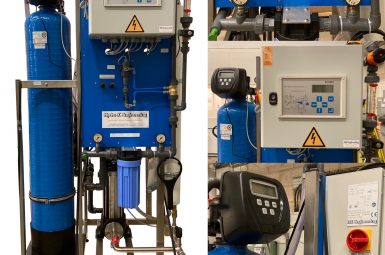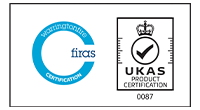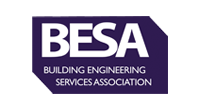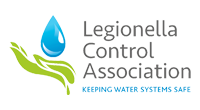Technology Spotlight – Chemical Dosing Pumps
Chemical metering pumps, often referred to as ‘dosing pumps’ are selected to meter-controlled quantities of, most commonly, free-flowing liquids.
Metering pumps are offered in various ‘liquid’ displacement types:
Mechanical Diaphragm – for applications where the dosed liquid contains small amounts of suspended solids; the liquid contains a toxic solution; a drip-proof application is required, and displacement pressures do not exceed 20 Bar.
Hydraulic Diaphragm – for applications where the dosed liquid is abrasive; contains small amounts of suspended solids or the liquid contains a toxic solution. Hydraulic design/ pressure stability either side of the diaphragm enables greater pressure capabilities and extends diaphragm life.
Piston Plunger – for applications where the dosed liquid is non-abrasive; a drip-proof application is not essential and where a high-pressure discharge is required.
Peristaltic – popular for smooth pulse-free displacement commonly for low-pressure applications.
Motive Drive
Various ‘drive’ options available:
Electromagnet – more commonly referred to as solenoid driven. Electromagnet driven dosing pumps occupy the lower end of the duty scale typically 0-100 Lph, 0-20 bar and almost exclusively make use of mechanical diaphragms.
Positive Stroke, Spring Return Gearbox – a motor-driven gearbox arrangement providing versatility in terms of displacement types. Often abbreviated simply to ‘Spring Return’ they cover a larger range of duties typically 0-1,200 Lph, 0-250 bar.
Positive Stroke, Positive Return Gearbox – another motor-driven gearbox arrangement. They cover a wide range of duties and can achieve the coveted API675 standard required in higher-end applications. Duties range from 0-4,000 Lph+, 0-250 bar.
Stepper Motor – similar, in a manner of speaking, to electromagnet pumps. Stepper motor pumps allow for very small, incremental, displacement of liquid leading to increased accuracy across a flow range. Many other drive types achieve 100:1 or 200:1 ‘turndown’ ratios whereas stepper motor pumps can deliver values such as low as 4800:1 – that is 4,800 potential adjustment increments – ml or fractions of ml! Another advantage to this system is a ‘smooth’ delivery – the other drive types give a pulsed output due to the positive stroking nature – unless a mitigating device such as a pulsation dampener is fitted.
Consideration should also be given to your incoming power supply. Electrical connections vary by voltage, phase, frequency (Hz) and current flow type (AC/DC). Variation can present itself not only by the setting (i.e. domestic household vs industrial unit) but by country. 60Hz will have a greater flow output than the same pump operating at 50Hz etc. Alternatives to electrical supplies, such as pneumatic /hydraulic come with their own unique challenges.
Liquid End Materials
Liquid end materials must also be considered carefully. Most refer to the pump head as the ‘liquid or wet end’ however there are other areas that must be considered. A more complete definition would be any part of the pump that does or is expected to, come into contact with the process fluid. For the majority of cases, simple material compatibility checks between the process fluid and liquid end materials are sufficient (complicated slightly if using ‘mix’ or ‘blended’ chemicals). Liquid end materials may also have an impact on the performance ability of the pump e.g., plastic liquid end materials may not be suitable for higher pressure/high-temperature applications.
Process Review
Several process factors will often dictate which of the above variants are appropriate including specifics and characteristics of the liquid to be handled; hydraulic factors such as the arrangement of the dosing pump within the process etc. Most critical is the ability to consider the process as a whole – the bigger picture so to speak.
Inevitably, Nett Positive Suction Head (NPSH) will factor into your considerations. NPSH is widely known throughout the industry however it is fair to say, seldom fully understood. There is a substantial amount of theory work behind NPSH – far too much for this article and so, it will only be covered in basic terms.
NPSH is primarily used in centrifugal or borehole transfer pumps, though the principles should also be applied to dosing pumps. NPSH, as the name would suggest, concentrates on the suction side of the pump. It breaks down into two components – NPSH Required (NPSHR) and NPSH Available (NPSHA).
NPSHR is defined by the manufacturer of the pump and is the minimum suction pressure that needs to be exceeded for correct pump operation and, more so in transfer pumps, to prevent cavitation (low-pressure bubbles exposed to a high-pressure environment which subsequently collapses causing a shockwave). NPSHR is calculated under test conditions.
NPSHA relates to the hydraulic arrangement within the installation and is primarily the suction-side pressure less the vapour pressure of the pump fluid at that point. NPSHA must exceed NPSHR under the prevailing conditions (all temperature variations, friction losses etc) to ensure that the pump operates correctly, and premature failure is avoided.
Control Variants
Once the ‘mechanical/hydraulic’ aspects have been reviewed, there are several control options to consider; principally whether an analogue or digital unit is required. In simplistic terms, whether ‘processing’ is to be in the form of a standalone/external process controller or will be an integral part of the pump.
The number of control options increases on an almost annual basis with some of the more recent offerings including process fluid leakage alarms, overpressure detection within the unit and fluid displacement feedback.
Injection Volume
Following on from the overall hydraulic arrangement; injection volume (i.e. ml displaced per stroke) can have a critical effect on process efficiencies such as time between injections and liquor dispersal, whether pulsation dampeners or static mixers may be required and so on. Minimum turndown ratio of the pump can have a dramatic effect on repeatable accuracy (e.g. a manufacturer may recommend that the pump not be turned down below a certain percentage of rated capacity) therefore pump capacity performance curve review along with individual pump calibration must also be considered.
Environment
The environment within which the pump will be located will have an impact on selection. IP rating (the pump electricals ability to deal with water/particle ingress/immersion) and ATEX rating (protection against explosive atmospheres – gasses, mist, vapours, or combustible dust) are perhaps obvious examples. External temperature variances can have a dramatic effect on pump performance – not only on the pump itself (overheating etc) but on the behaviour of the liquor e.g. solidifying, gassing etc. This is covered as part of NPSH calculations but should also be considered on a more practical level.
What Next?
This overview has been written to be a helpful initial guide to Chemical Dosing or Metering Pumps and their application. Hydro-X Engineering works with our customers to deliver truly bespoke water treatment process engineering. We would love to talk to you about your project or application to see how we can help you and your business to achieve a responsible, sustainable and future-proofed engineering solution tailored to your individual challenges. Our future-facing mindset sets us apart from your average water treatment company.
Discuss your project with one of the Hydro-X Engineering team today.
